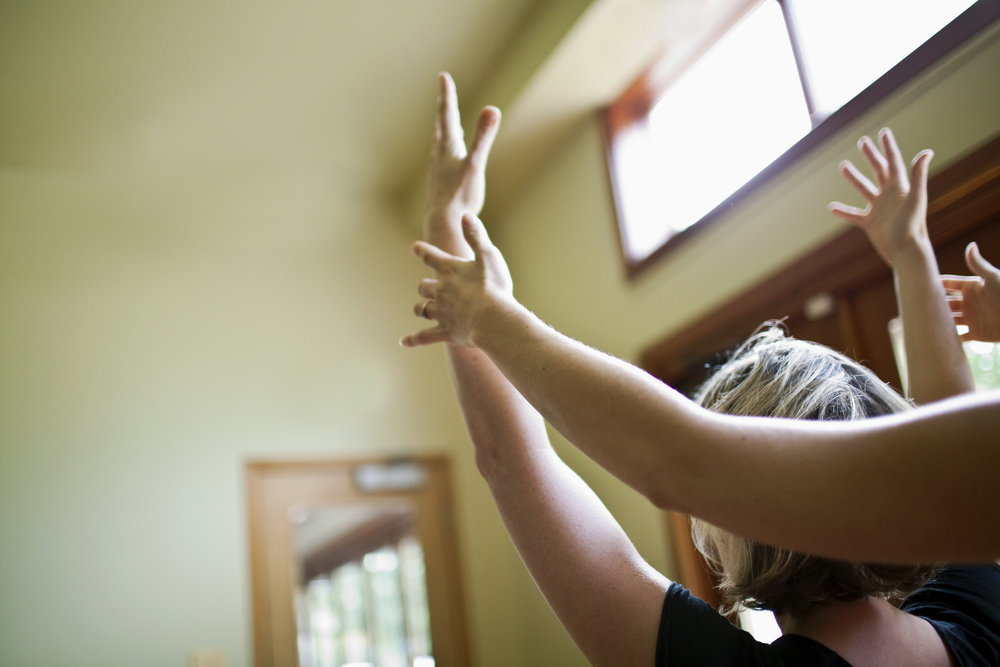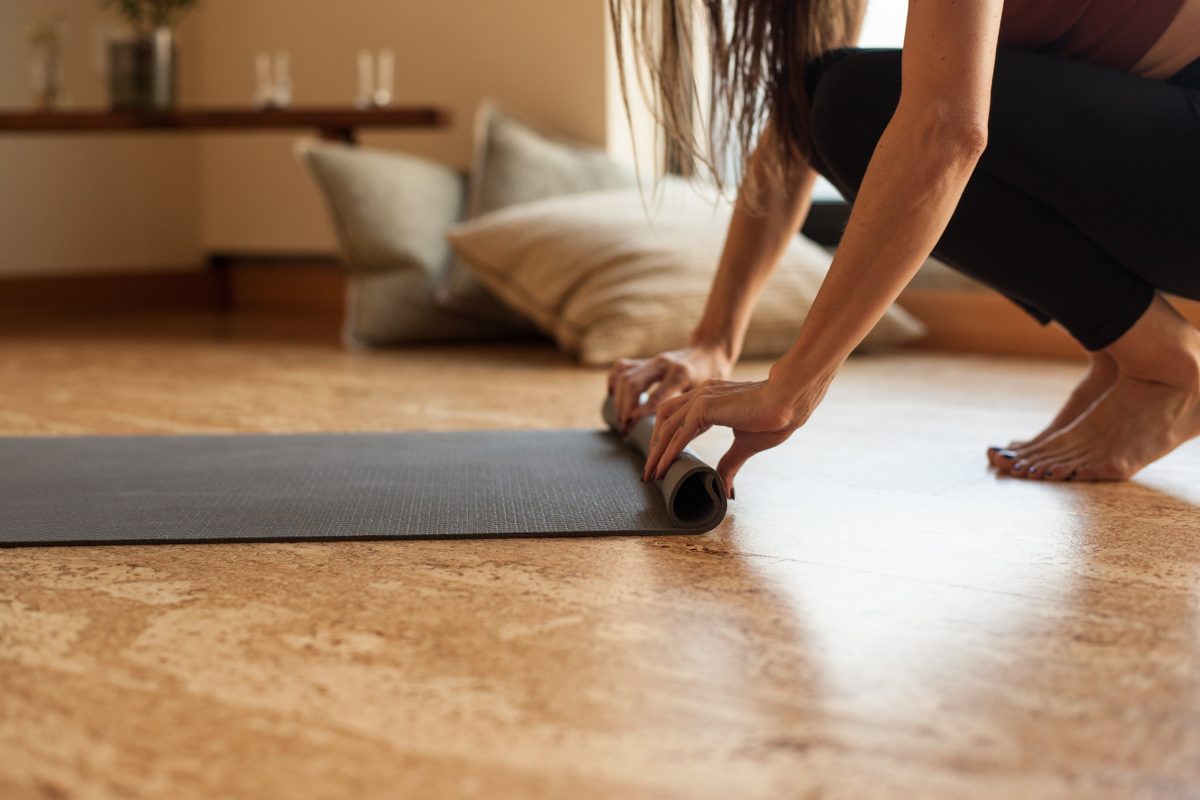
By Jeannette Sager, Yoga Instructor at Root Whole Body
In the years that I’ve been teaching yoga full time, my personal practice has dwindled. . .and died. It wasn’t even a slow fade – one day I had a yoga practice, and the next day, I didn’t.
It’s not difficult to describe the reasons why a yoga teacher would neglect her personal practice, although certainly there must be an expectation that yoga teachers maintain some of the most dedicated & consistent practices of all the humble yogis walking the earth. Many teachers do, but for some of us, it’s a difficult balance to maintain. Aside from the fact that we are usually teaching at any time there would feasibly be a yoga class on the schedule somewhere, even if we had the time available, we might be any of the following: too exhausted, suffering from overuse injuries or other strain, or (as is often the case for me,) not really in the mood to roll out the mat after I’ve been doing it ALL. DAY. LONG.
Let me not understate the level of disappointment that accompanies the surrender of something I once loved to do – it was not with joy that I let a once-cherished pastime go. It seems that this is a common outcome for people who pursue something they love as a career, as a beloved hobby becomes work, as the pressure of financial dependence mounts, especially on something that doesn’t pay as well as some of the careers we may have left in pursuit of our passions. Where I used to eagerly await the end of the workday, when I could turn to yoga to release the stresses of the day, it quickly became the last thing I wanted to do when I had a moment to myself.
In sensing my personal practice slipping away from me, I noticed that my teaching began to suffer. While I used to teach a few classes a week when I was in school or as a supplement to my full-time job, I also kept up a dedicated practice of my own. I loved the way teaching allowed me to share my personal revelations and discoveries with my students, and I felt that we were on the journey together. When it became my full-time gig, that feeling quickly evaporated. I was suddenly never in the mood to practice, and therefore, I was never in the mood to teach. I wasn’t creative in putting my classes together and found myself falling back on the same stale flows. I had stopped infusing my classes with themes and quotes and the elements of energetic mystery and spiritual development that had attracted me to yoga in the first place.
I really noticed how stunted my teaching was when I did finally attend another teacher’s class and I was amazed by how weird it was. It hardly felt like yoga, or at least not the yoga I had expected, and it was much more fun than I had expected it to be. In reflection, I realized that the teacher could only have arrived at such a unique teaching style by experimenting a lot in his own practice. It requires play to learn to make yoga out of such non-traditional movements and shapes, and that was something I was missing, not just from my practice, but from my life.
So what was I to do now, finding it so difficult to extract joy from my own practice, or even muster up the will to attend to it? How was I going to re-infuse my practice with the love and energy that I used to bring to it, and how would that make me a better teacher?
Most importantly, how would that renewed focus improve my everyday life?
So much of what we are teaching in yoga is that the practice is not confined to time on the mat. It’s when we take our yoga out of the studio – when we begin to live it – that we really begin to transform. What was missing from my life wasn’t asana, it was that I had allowed the absence of practicing asana to blind me to the yoga that was all around me. It was no longer realistic for me to expect to be able to attend a yoga class every day, or even once a week. I recognized that it might even be awhile before I felt like it again, but that didn’t have to stop me from having a yoga practice.
I started to feel that when I stepped into the yoga studio to teach, I was also stepping in to a practice much deeper than any I had ever known. I became more present to what I was doing, more aware of myself in the role of teacher and how that had become my journey. It struck me that I had arrived at the perfect opportunity to really do the thing I thought I had been working toward all along: to be of service.
Teaching asks a lot of a person. Like any job, I have days when I am excited and eager to do my work, and days when I feel tired or injured or am suffering from menstrual cramps. And, like any other job, I still have to show up. But unlike some other jobs I’ve had, I can’t close the door to my office and slog through the day. I have to show up completely, and I have nothing to hide behind. Teaching yoga challenges me in ways I never imagined. It asks me to call up all the knowledge I’ve managed to gather and apply it, which always just leads to more questions. It takes me much further out of my comfort zone than any difficult pose I ever tried or sweating through a Bikram class for the first time. It is in this space that I see myself stretching, and it makes the tired/sick/injured days worth it.
Among other things, yoga asks me to hold space for others. Always. I’m an introvert by nature and it requires a lot of energy to be out there for a room full of people, compassionate and caring every step of the way. I had never previously considered myself to be lacking compassion or empathy, but I had never been expected to show up with a full heart when I hadn’t already planned on doing so. I’ve had to dedicate myself to the important work of asteya, or non-stealing, which includes not stealing from one’s self, and aparigraha, or non-attachment, especially to the things that drain my energy. That has meant holding boundaries and maintaining a rigorous self-care practice so that I can show up every day and be the most compassionate, space-holding teacher I can be. As long as I’m taking care of myself, the less I have to hold back. I have so much more to give, and the returns have been tremendous.
Perhaps the most progress I’ve made through teaching is having to confront everything I would rather ignore. In my personal practice, I have noticed that I tend to avoid what makes me uncomfortable. In my classes, I often share the story of the day I realized that I had the habit of leaving my water bottle across the room so that, during Sun B, I would have to step away from my mat (and chair pose) to quench my thirst. In reality, chair pose shows me everything I don’t like about myself: I have physical limitations that make it uncomfortable, and I am not accustomed to struggling at physical tasks. On top of that, it makes my thighs bulge out, and the sight of myself doing the pose puts me right back in ballet class as a younger woman, picking myself apart (a shame that I have also attempted to avoid over the years, rather than confront.) There’s really nothing about it that I enjoy, and so it seemed like a pretty good time to grab a drink of water. . .every single day. And honestly, if I ever didn’t feel like doing something, I probably wouldn’t, and that has included practicing yoga.

Despite seeing that in myself, I’ve still struggled to face the things that bother me, but teaching yoga is a job in which you receive a lot of feedback, most of it unsolicited. I have learned so much about what people think of what I teach, what I wear, the music I play, the sound of my voice, the amount of “spiritual” material with which I infuse my classes, the length of time I allot for savasana, the stories I share about myself, and the “mistakes” they observed others making that I didn’t address. In the spirit of service, all feedback is useful and welcome. It’s fair for people to share what works for them and what doesn’t, because this is an important part of their lives. Because teaching anything, especially something like yoga, is extremely personal work, sometimes the feedback hits close to home, whether it’s meant to or not. I’ve never had a job where evaluation and feedback weren’t part of the package, but even as a fairly sensitive person, it has never seemed quite as difficult to hear as it can now. It’s impossible to never have one of those tired/sick/injured days when I’m not at my best, and that makes being a bit off my game feel like absolute failure.
However, there’s no avoiding it anymore. It’s unfair to think, “I don’t care what they say,” or, “They don’t know what they’re talking about,” because I do care what they say – my job (and my desire) is to provide a safe and healthy space for everyone to practice – and they do know what they’re talking about because it’s their practice. Again, it’s important to establish boundaries and acknowledge that, although it’s impossible to please everyone, there is something universal in every bit of feedback that comes my way. If I make a mistake, I have to own up to it and hold enough compassion for myself to face it without self-judgement. I have to give it room to change the way I teach, and therefore, potentially change me.
Above all, teaching has asked me to embrace “practice” as an evolving term. I used to enjoy a rigorously athletic practice that made me feel strong and powerful and, if I’m honest, kind of better than everyone else (insert “oops” emoji here.) These days, I’m grateful if I can get in 15 minutes of stretching and a few sun salutations. Part of the discipline of a practice is showing up and doing what you can, and some days, what I can do is lie in bed in supta badha konasana until I fall asleep. There’s no showing off in the physical practice I maintain these days, but there is a good deal of acceptance in it, and that’s something I’ve never been able to do easily. I feel more accepting now, more awake, more loving of myself and others, than I ever have before.
It is often said that the best way to really learn something is to teach it, and in the way that teaching has become a form of yoga for me, I’ve begun to seek – and learn to see – opportunities to practice in all of life. We are so often told to take our yoga “off the mat”, which is what teaching has given me so much opportunity to do. Ultimately, that is the practice. It’s wonderful that we can show up and mold our bodies into shapes and breathe deeply and slow down or sweat or whatever it is that we get from the physical practice. While asana practice remains an important opportunity to observe and accept ourselves, the real invitation to practice begins when we leave class, when we proceed into our lives beyond the yoga studio. Yoga happens at the times when there’s no teacher there to remind us what to do or think about, when we are responsible for ourselves and the way our words and actions affect the people we encounter. Maybe it begins with something as small as forgoing the use of headphones the next time you take a walk so you can really tune into the sounds of what’s around you. Maybe it means doing something ordinary with a little more attention, like cooking a meal, making the bed, or locking the front door as you leave the house. Maybe, over time, all those little things evolve into more kindness for others, less susceptibility to drama and emotional upset, and an overall more mindful, intentional way of living.
I would like to report that every time I take out the trash, I take time to breathe and be mindful about it, transforming a mundane task into the door to enlightenment, but I don’t. I’m just struggling along like the rest of us, maybe more than most. What I’ve learned from teaching – and having to always show up for it – has taught me more than I ever got from simply rolling out my mat to practice the way I always did before. It doesn’t mean we all have to become teachers, but it means that we can benefit from letting the lives we live outside of yoga class become an extension of our time on the mat. Anything that we do can be our yoga if we allow it, and that is where we really begin to evolve.



